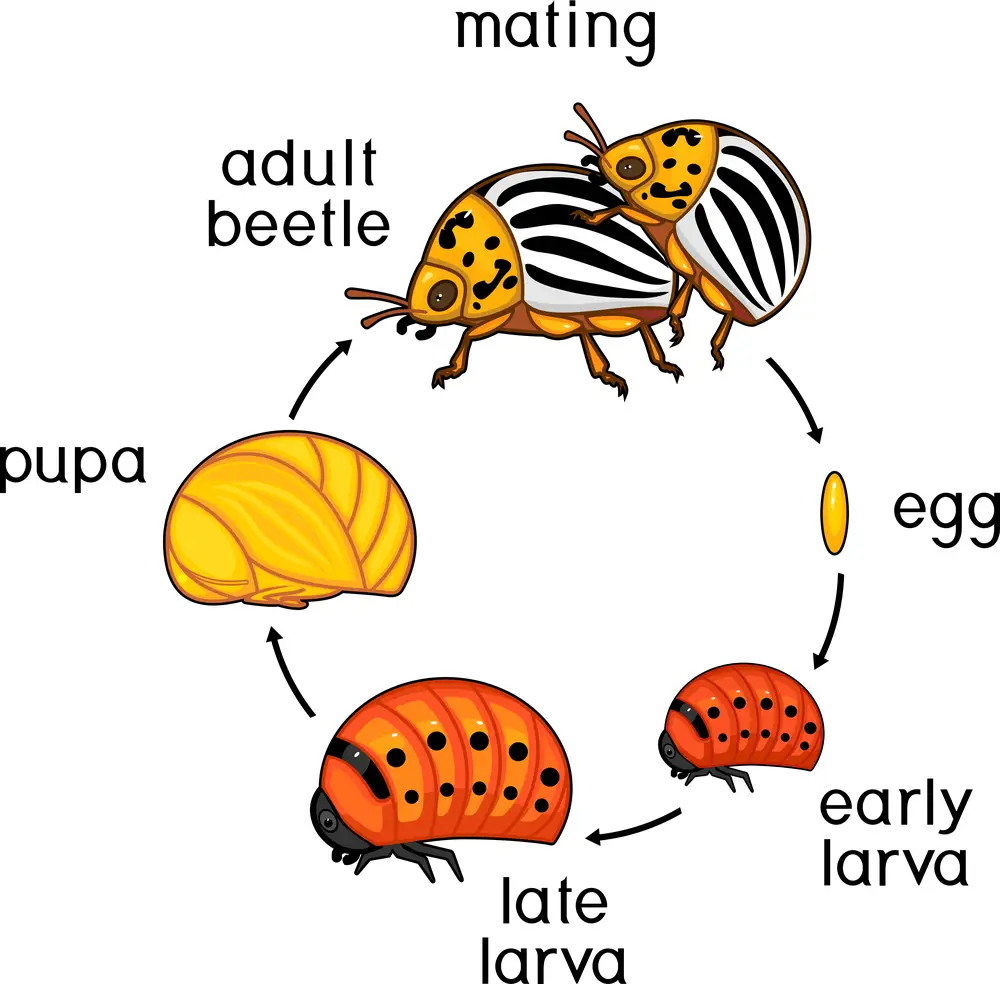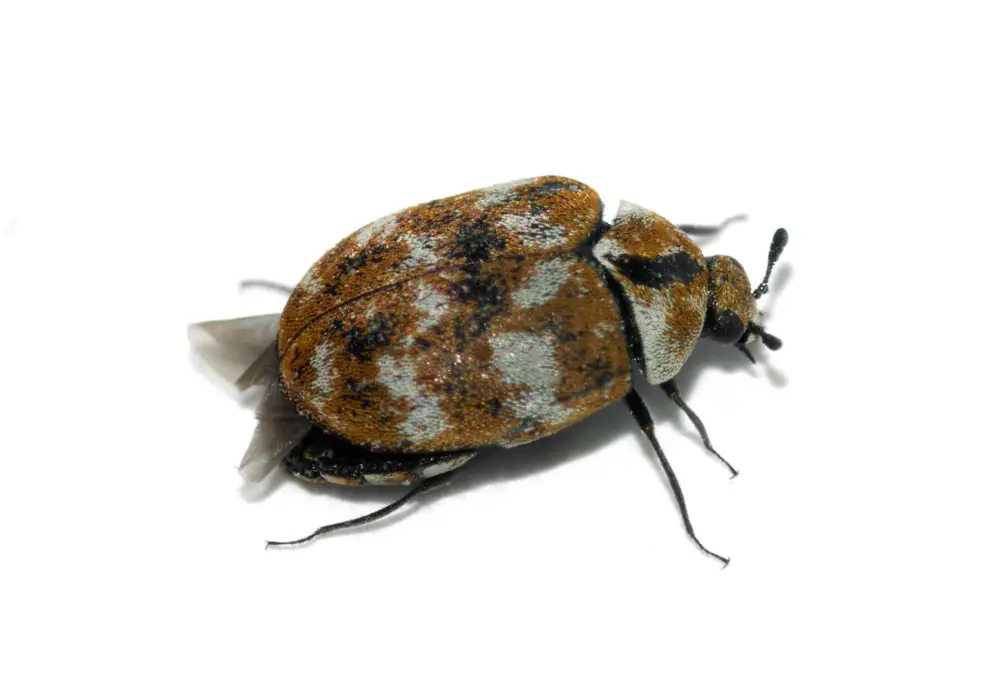Carpet beetles are a common household pest, known for their preference for natural fibers in carpets, upholstery, and other furnishings.
While they may not pose a direct threat to humans, pet owners, especially cat owners, may wonder whether these small insects could be harmful to their feline companions.
Quick Answer:
Carpet beetles aren’t directly harmful to cats. But, their larvae’s bristly hairs might cause an allergic reaction or irritation if ingested or in contact with the cat’s skin. Despite not being typically dangerous, it’s advisable to keep pets away from infestations.
Carpet Beetles and Cats
Harmful Effects
Carpet beetles are common household pests that can infest carpets, fabrics, and other areas of your home. While they primarily target organic materials like wool, hair, and cotton, they could also potentially cause problems for your cats.
The larvae of carpet beetles have small, hair-like bristles that may irritate a cat’s skin if they come into contact with it.
Bites and Allergic Reactions
Carpet beetles don’t typically bite cats or humans; they are more focused on consuming fibers and dead skin cells. However, some cats might be sensitive or allergic to the fibers shed by carpet beetle larvae, which can lead to irritation, itching, and discomfort.
In rare cases, a severe allergic reaction may occur, but it is not common.
Symptoms to Watch For
If you suspect that your cat might be experiencing issues due to carpet beetles, keep an eye out for the following symptoms:
- Excessive scratching or grooming
- Red or inflamed skin
- Hives or rashes
- Hair loss or thinning
- General discomfort
If you notice these symptoms, it is important to consult with a veterinarian for appropriate treatment and advice.
Additionally, taking measures to control and prevent carpet beetle infestations in your home will help protect both your belongings and your feline friends.
Carpet Beetles Life Cycle

Carpet beetles, like many other insects, go through a complete metamorphosis during their life cycle.
This involves four stages: eggs, larvae, pupae, and adults.
Eggs: The adult female carpet beetles of various species begin laying eggs during the warmer months.
They can lay anywhere from 30 to 100 eggs at a time. These eggs are extremely small and easily blend into their environment, making them hard to notice. They generally hatch within two weeks.
Larvae: The larval stage is the most destructive phase of the carpet beetle lifecycle. After hatching, the larvae start feeding on various materials, including fabrics, feathers, and even hair.
As they feed, they grow and molt several times, shedding their skin and leaving behind evidence of their presence. This stage can last anywhere from 2 months to 2 years, depending on the species and environmental conditions.
Pupae: After completing the larval stage, carpet beetle larvae turn into pupae. Pupation is a transitional phase that lasts for about 10-12 days. During this time, the insect undergoes significant changes and prepares itself for the final stage of its life cycle.
Adults: Once the pupal stage is completed, the fully-grown adult carpet beetles emerge. At this point, they cease causing damage to fabrics and other materials. Instead, the adults focus on reproduction. The adult stage typically lasts for around two months, though some species may live up to a year.
Carpet Beetle Infestation

Carpet beetles are small insects that can infest various household items, including carpets, upholstery, and clothing. They often go unnoticed until the infestation has become severe.
While carpet beetles are not directly harmful to cats, their presence can signal other issues in the home that may affect your pet’s health.
One of the first steps to deal with carpet beetle infestations is identifying their presence. Look for small, oval-shaped, and multi-colored carpet beetles alongside shed larval skins, tiny fecal pellets, or holes in your carpets, upholstery, or clothing.
Vacuuming is essential in controlling and preventing carpet beetle infestations. Regularly vacuum all areas of your home, paying special attention to carpets and upholstered furniture.
Dispose of the vacuum cleaner bag or empty the canister immediately after use to prevent the beetles from re-infesting your home.
In addition to vacuuming, it’s crucial to wash your pet’s bedding, toys, and any affected clothing or linens in hot, soapy water. This will kill any carpet beetles and their larvae clinging to the fabric.
Steam cleaning carpets, rugs, and upholstery can also help eliminate carpet beetles and their larvae.
If the infestation persists despite regular cleaning efforts, it may be necessary to use insecticides specifically labeled for carpet beetles. Consult a professional exterminator for advice and to ensure the safety of your pets during the application process.
Preventing Carpet Beetle Infestations
Carpet beetles can be harmful to cats, especially if they ingest the beetles or their larvae. To protect your furry friend, it’s important to take steps to prevent carpet beetle infestations.
By following some of these tips, you can keep these pests at bay and ensure your pet’s safety.
A thorough cleanup of your home is crucial in deterring carpet beetles. Vacuum your carpets regularly, paying close attention to areas under furniture or around baseboards where beetles can hide. Don’t forget to wash pet bedding, plush toys, and other potential carriers of larvae.
Sealing any gaps and cracks around windows and doors can also help to prevent carpet beetles from entering your home. Check the weather stripping and ensure it’s in good condition, as this can keep not only carpet beetles but also other pests from gaining access.
Store your pet’s food, toys, bedding materials, and any other belongings in airtight containers. This will make it more difficult for carpet beetles to reach their preferred food sources and breeding grounds, which can help deter their presence in your home.
While humans may not be directly affected by carpet beetles, prevention is essential for your cat’s health.
Consider using insecticides labeled for carpet beetle control, focusing on the areas where these pests are likely to hide. Make sure to follow the product instructions and keep your cat away from the treated areas until the insecticide has dried.
Natural deterrents such as diatomaceous earth can be useful in controlling carpet beetles without posing a risk to your cat. Sprinkle this powder in areas where carpet beetles may be present, and vacuum it up after a few days, repeating the process if necessary.
- Say Goodbye to Bugs – Kills a variety crawling insects including roaches, ants, fleas, silverfish, earwigs, bedbugs, and more
- Attracts and Kills – Made from diatomaceous earth and selected baits, this powder causes insects to dehydrate and die within 48 hours after contact
- Mechanical Killer – Unlike many traditional chemical insecticides, insects cannot build an immunity to diatomaceous earth
Remedies and Treatment for Affected Cats
Carpet beetles can cause harm and discomfort to cats, primarily through their tiny, barbed hairs that can cause irritation and itching. If you suspect that your cat has been affected by carpet beetle infestation, it’s important to address the issue as soon as possible.
The first course of action should be to consult a veterinarian. They can accurately diagnose the problem, assess the level of harm, and prescribe the appropriate treatment. This may include medication to alleviate itching or pain and prevent infection.
In conjunction with veterinary care, it’s crucial to target the source of the problem – the carpet beetles themselves.
Thoroughly clean your home by vacuuming carpets and upholstered furniture to remove any beetle larvae and their hairs that could harm your cat. Wash your cat’s bedding and toys in hot water to eliminate any remaining beetle eggs or hairs.
Consider using a spray that’s specifically designed to kill carpet beetles in affected areas in your home. However, ensure that the product you choose is pet-safe since some sprays could be toxic to cats. If needed, consult your veterinarian for recommendations.
To prevent future infestations, practice regular, thorough cleaning, and address any sources of moisture or food that may attract carpet beetles. It’s also advisable to have your home inspected and treated by a professional pest control service to ensure complete elimination.
Pest Control for Carpet Beetles
Carpet beetles can be a nuisance in your home, but being informed about their habits and the available pest control methods can help you minimize their impact.
While their larvae can be harmful to cats, there are several effective and safe ways to control these pests.
One of the most reliable methods to eliminate carpet beetles is to hire a professional exterminator. They are experienced in handling various pests and can quickly identify the type and extent of the infestation.
They will use the appropriate pesticides and techniques to ensure the safety of your cat and the effectiveness of the treatment.
However, if you prefer to handle the issue yourself, there are several home remedies to try. First, maintain a clean and clutter-free environment to reduce hiding spots for the beetles.
Vacuuming regularly, including upholstered furniture, curtains, and carpets, will help remove larvae and eggs.
You can also use natural repellents, such as essential oils. A mixture of water, white vinegar, and a few drops of lavender, peppermint, or eucalyptus oil can deter carpet beetles. Spray it on affected areas, being careful not to harm your cat.
Some other pest control options include:
- Freezing: If the infested items are small, like clothes or linens, you can put them in the freezer for 48 hours to kill the beetles and larvae.
- Hot water treatment: Wash infested fabrics in hot water (at least 120°F) to eliminate the pests effectively. Make sure the items can withstand the heat.
- Insecticides: Use pet-safe insecticides specifically designed for carpet beetles. Follow the instructions on the label and keep your cat away from the treated area until it’s dry and safe.
Frequently Asked Questions

Are Carpet Beetles Poisonous?
Carpet beetles are not poisonous to cats and do not pose a significant threat if ingested. However, their hair and shed skin can cause irritation to your cat’s digestive tract, leading to discomfort and potential allergic reactions.
What Do Carpet Beetles Look Like?
Carpet beetles are small (about 1/8 to 3/16 inches long) oval-shaped insects with a variety of colors depending on the species.
Some common features include:
- Black carpet beetle: shiny black or dark brown with brownish legs
- Varied carpet beetle: multicolored with white, brown, yellow, and black scales
- Furniture carpet beetle: similar to varied carpet beetle, but with a white and yellow pattern
Adult carpet beetles have wings and are capable of flying, while larvae are smaller, fuzzy, and worm-like.
Where Do Carpet Beetles Come From?
Carpet beetles are attracted to a variety of materials, including fabrics, carpets, and upholstery. They can enter your home through openings such as windows, and doors, or even hitch a ride on personal items or secondhand purchases.
Once inside, they will seek out dark and undisturbed areas to lay their eggs, such as closets, attics, or underneath furniture.
How to Get Rid of Carpet Beetles?
To effectively eliminate carpet beetles, follow these steps:
- Clean and vacuum: Remove all debris and thoroughly vacuum your carpets, upholstery, and other fabrics to remove adult beetles and larvae.
- Launder-infested items: Wash infested items in hot water with detergent to kill eggs and larvae.
- Use insecticides: Apply a safe insecticide to affected areas, ensuring that it’s approved for use on carpets and fabrics. Be sure to follow the manufacturer’s instructions, and if in doubt, consult a professional exterminator.
- Prevent re-infestation: Regularly clean and vacuum your home to minimize potential food sources for carpet beetles. Store unused fabrics and clothing in sealed containers and inspect second-hand purchases before bringing them into your home.



